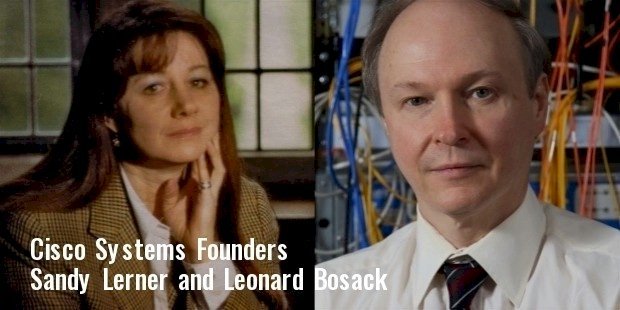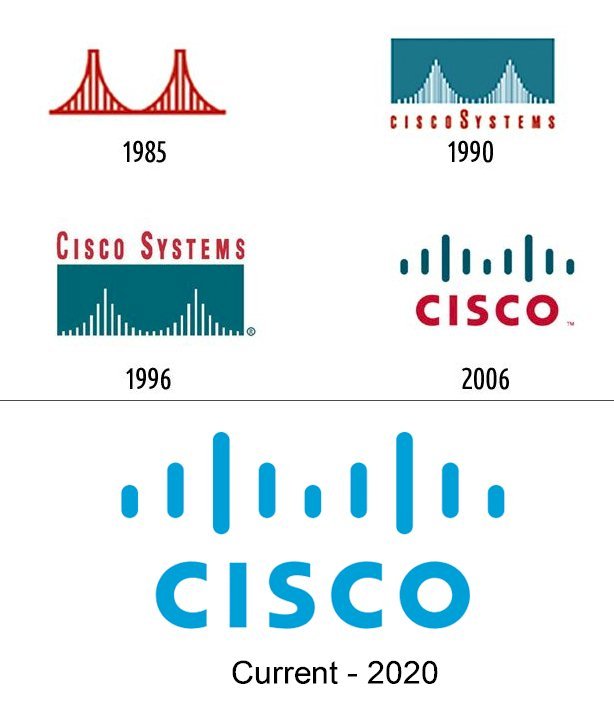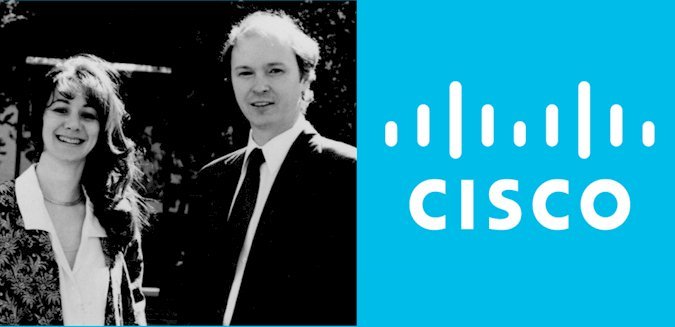This is a look at the Cisco Logo and its Impressive History. Their logo and brand has grown to be one the biggest tech companies in the world.
Cisco and the iconic Golden Gate Bridge have something in common. Can you guess it?
Cisco, the world leader in information technology, networking, and cybersecurity, shares the same iconic symbol of the Golden Gate Bridge. The founders coined the name Cisco from the last five letters of San Francisco. In this article, you will learn the history of Cisco, the evolution of its logo, and how the logo has helped it to become one of the most recognizable brands in the world.
History of Cisco Systems

Husband and wife, Leonard Bosack and Sandra Lerner founded Cisco in December 1984. The couple met at Stanford University. In the earlier 1980s, it was the norm at Stanford University for students and staff to use a technology called ‘Blue Box’ to link all computer systems on campus to interact with each other. The ‘Blue Box’ acts like a multiprotocol router, and it uses software written by William Yeager, a research engineer at the university.
Williams’ software laid the foundation for Cisco IOS and its earlier path to success. In 1985, when Bosack and Kirk Lougheed decided to start a project to link Stanford’s campus, they opted for William’s software without his permission. On July 11, 1986, the university threatened to file legal charges against Cisco for stealing its intellectual properties. The university compelled Bosack and Lougheed to resign, so it didn’t pursue the case further.
Finally, in 1987, Stanford licensed the router software and two other computer boards to Cisco. The company appointed Bill Graves as its first CEO. He worked alongside Bosack, Lerner, Lougheed, Greg Satz, and Richard Trojano, forming the first executives.
In 1988, though sales volume grew, the founders needed extra capital to inject into the business. So, they seek financial support from Donald Valentine, a venture capitalist, who provided the money but under strict conditions – taking control of the company.
With this power, Donald became the chairman, and he appointed John Morgridge as the new CEO. Morgridge carried out a staff reshuffling, appointing Bosack as chief scientist and Lerner head of customer services.

By February 16, 1990, Cisco had achieved a market cap of $224 million and officially went public. Six months after going public, the founders parted ways with the company. The executive board fired Lerner on August 28, whereas the husband, Bosack, resigned. Bosack and Lerner sold their stakes in the company and donated the proceeds to charities.
For predicting that routers and Ethernet switches will dominate the future, Cisco launched product models like cisco 2500, cisco 7000, and Cisco 8500 to the market, making it one of the successful forerunners in commercial routers that supports several network protocols.
Cisco continued its expansion. Within two years (i.e., 1992 to 1994), acquired some companies in Ethernet Switching such as Kalpana, Grand Junction, and Mario Mazzola’s Crescendo Communications, together forming the Cisco Catalyst Business Unit. In 1995, John Morgridge stepped down as CEO for John Chambers.
In 1999, Cisco acquired several businesses. Few of them were GeoTel, Cerent Corporation, and Aironet Wireless Communications Inc. Cisco bought Cerent Corporation for about $ 7 billion, becoming the most expensive acquisition by Cisco.
During the dot.com bubble, Cisco saw a massive opportunity in the Internet Protocols (IP) services. So, Cisco launched Modem Access Shelves (AS5200) and Core GRS Routers. By late 2000, Cisco had achieved a market cap of over $500 billion, becoming the world’s most valuable company.
Many start-ups were starting to find simple methods for processing Internet Protocols, which were complex at the time. Juniper Networks was one of the start-ups to lead the search for solutions, and 1999, it introduced its first product into the market. In less than a year, Juniper Networks have taken about 30% shares of Cisco’s SP market. Cisco launched ASICs, a fast processing card for GSR routers, and catalyst 6500 switches in reaction.
And in 2004, Cisco Systems began the migration to new high–end hardware CRS–1 and software architecture IOX–XR. In 2006, Cisco Systems launched the ‘Human Network’ advertising campaign to make its name a household one. This rebranding exercise saw the modification of its name to ‘Cisco.’
Cisco continued to develop its primary products – routers, switches, and security protocols. With a growing interest in Ethernet, restrictions in IOS, and aging crescendo architecture, Cisco was forced to look at merchant silicon in the carrier Ethernet division.
The research led to the launching of ASR9000 and subscriber management around EZChip–based hardware and IOS–XR. In 2000, Cisco spent $1 billion to build its Globalization Centre in Bangalore, India. Also, Cisco bought Starent Networks, a mobile specialist, to continue its expansion and authority in 2009.
In 2011, competition became increasingly fierce. The likes of Alcatel–Lucent, Juniper Networks, and Huawei became strong competitors in the industry. As a result, Cisco anticipated profit was reduced exponentially. In response, the company cut down annual expenditure by $1 billion and employee strength by 3000 jobs cut.
Cisco purchased NDS (a television software company) for $5 billion in July 2012. This acquisition was made possible with the help of the European Union. In 2013, Cisco moved away from selling to consumers to businesses, and its first deal was a sale of its Linksys home – router unit to Belkin International Inc.
Furthermore, Cisco announced the acquisition of Sourcefire for $2.7 billion in July 2013, while downsizing its workforce by 4000 jobs cut in August. By the end of the 2013 fiscal year, Cisco reported a low revenue due to economic uncertainty. Cisco has made significant impacts on the world of technology. Some of its products are routers, switches, protocol translators, internet service devices, remote access services, and voice over IP services. Today, the Vanguard Group, Black Rock, and State Street Corporation primarily owned Cisco.
The History of Cisco Logo

The leaders of Cisco knew the impact a unique and professional-looking logo would offer their start-up. As early as 1984, they began searching for that unique symbol to represent and communicate their vision, mission, and heritage. So, it was no surprise that the Cisco logo design was an inspiration taken from the iconic Golden Gate Bridge, a national monument that began in 1933 and commissioned on May 27, 1937.
A report by John Morgridge, Cisco’s second CEO, suggests that on the way to Sacramento to register the start-up, the founders, upon reaching the Golden Gate Bridge, were awe-inspired that they couldn’t help but to admire its enchanting beauty. Immediately, they were convinced that the bridge represents what they intend to offer the world.
The Cisco logo has evolved with the times – representing its interests, opportunities, and challenges. The company used the original logo from 1985 to 1990. After that encounter with the Golden Gate, the logo was developed in-house under Gary McCavitt, Cisco’s Director of Brand Identity. The logo featured a minimalistic red illustration of the Golden Bridge’s original shape, with thin but outstanding lines. The name ‘Cisco’ wasn’t part of the design.
Cisco modified its original logo in 1990. This time, the traditional red bridge paved the way for a white bridge, resting comfortably in a rectangular sea-blue background. The logo further depicted the company’s name ‘Cisco Systems’ in red under the rectangle. Cisco used the new logo for six years.
The logo had its second modification in 1996. Though the iconic white bridge maintained its features, the sea-blue lost its shine to a darker blue shade. The white bridge looked stable and vibrant under the influence of the new background.
Simultaneously, the name retained its red color, but its first letters – C and S were written in uppercase letters. Also, the company’s inscription moved to the top of the rectangle. The new logo has represented Cisco for a decade. It looked bold, professional, and projected the vision of the company – a digital signal.
In 2006, as the company’s name shortened to ‘Cisco,’ its logo changed with it. The iconic white bridge had only nine bold dark blue strokes over a transparent background, with the name ‘Cisco’ boldly inscribed under it in red.. This new logo shows that aside routers and switches, Cisco provides the means for the world to network and communicate. This logo design served the company for seven years. The 2013 logo has only the color changed.
The Element of the Cisco Logo Design
 The most recognizable element of design in the logo is the iconic bridge. Though it has undergone some modifications over the years, it still represents the Golden Gate Bridge. The bridge, an element of design, highlights the founder’s heritage and vision to connect Francisco to the rest of the world.
The most recognizable element of design in the logo is the iconic bridge. Though it has undergone some modifications over the years, it still represents the Golden Gate Bridge. The bridge, an element of design, highlights the founder’s heritage and vision to connect Francisco to the rest of the world.
More so, the name ‘Cisco,’ which was coined from San Francisco and written in custom rounded typeface, represents the patriotism of the founders and their unwavering desire to celebrate Francisco and Silicon Valley as the technological center of the world.
Furthermore, the logo boasts of three color schemes – sea blue, white, and red. The sea blue, which formed the background cover of the second logo and the word-mark of the current logo, signifies trustworthiness, protection, tranquillity, and prosperity. The white hue means loyalty, whereas the red proudly communicate responsibility, passion, and readiness.
The Popularity of the Cisco Logo
The Cisco iconic logo has been at the forefront of the company’s strategic marketing campaigns. To reach a global audience and position itself as the worldwide giant in networking products, Cisco allocates 15% of its annual gross revenue to marketing.
The logo has represented the company and its quality products on television series, movies, documentaries, internet marketing, sport sponsorship deals, award ceremonies, and education certifications worldwide. Cisco featured in a documentary film entitled ‘Something Ventured’ which premiered in 2011.
Also, it has reached a broad audience through the numerous awards it has received. Cisco received the Ron Brown Award – a US presidential honor that recognizes companies for their quality relationship with their stakeholders. In 2010, Cisco received the Secretary of State Awards for Corporate Excellence.
Furthermore, Cisco is a massive supporter of technical education, and it has gained much publicity doing so. Cisco Academy Networking Program provides quality technical and certification education to students in more than 180 countries. This training helps students acquire information technology-related skills relevant to the industry.
The London 2012 Olympic Games, Rio 2016 Olympic Games, and the NBA sponsorships have all contributed to Cisco’s popularity. The company’s popularity hasn’t always been positive. For instance, people have accused Cisco of tax fraud, misleading stock statements, failure to comply with licensing models, and supporting the Chinese government to abuse people. In all earnest, the Cisco logo has been a great ambassador to the company’s epic rise from just a concept to a globally recognizable brand.
If you’re looking for professionals to create your next Technology Logo, kindly talk to us. At LogoMyWay, our topmost priority is your logo design. That is why we give you three different options: our in-house professional logo designers, or our famous logo contest, or our interactive Technology logo maker interface that aids you in doing it yourself.







